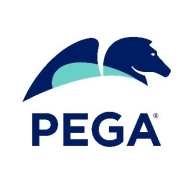

Pega Platform and WorkFusion are prominent competitors in enterprise software, focusing on business automation and case management. Pega holds an edge in enterprise-level solutions with features like robust integration and case management while WorkFusion shines in automation and machine learning capabilities.
Features: Pega Platform is known for adaptable features that accommodate rapid development changes, offer robust integration, and highly visual business processes, excelling in case management and enterprise-level solutions. WorkFusion offers efficient machine learning tagging, scalable robotic desktop automation, and robust document processing, making it outstanding in handling structured documents.
Room for Improvement: Pega Platform needs to improve price competitiveness and simplify licensing models, especially for SMEs. Users report a steep learning curve and demand better cloud capabilities and AI features. WorkFusion could enhance user-friendliness, machine learning integrations, and licensing cost structures, as the extensive Java requirement is considered burdensome.
Ease of Deployment and Customer Service: Both Pega Platform and WorkFusion support on-premises, public, private, and hybrid cloud deployments. Pega offers more robust on-premises and hybrid options, while WorkFusion benefits from public cloud flexibility. Both platforms provide satisfactory customer service, with Pega praised for responsive support and WorkFusion noted for quick resolution.
Pricing and ROI: Pega Platform is seen as expensive, especially for SMEs, due to high licensing fees and complex pricing models, though it promises significant ROI through improved business processes. WorkFusion is perceived as more affordable compared to competitors, requiring substantial initial investment but offering fair pricing with out-of-the-box features and eventual cost savings from automation.
The technical support from Pega is very low, rating a one or two out of ten.
I never needed support from the platform standpoint, but if additional features are required, we have regular meetings with the product team for feedback.
Pega's technical support team is very helpful.
They respond quickly, collect necessary logs, and sometimes propose new solutions.
Some issues are resolved quickly, while others might take time as they require further analysis.
Initial support often struggles to find solutions, leading to delays until more experienced personnel get involved.
Currently, big banking providers and insurance providers, even the members for healthcare payers, are using more than millions of operations on a daily or weekly basis.
WorkFusion is efficient for structured automation tasks with predefined templates and clear documentation.
The number of bots currently running on the platform should be more than 1,000, including RPA and non-RPA bots.
I frequently face issues with infrastructure and some WorkFusion-related problems, such as login issues.
WorkFusion requires a strong background in Java to meet requirements effectively.
Some stability problems may arise from processes that have not been designed or coded properly, leading to glitches.
With the recent development of AI agents in Pega Platform 24.2, the adoption is not heavy due to regulations around using external LLM by customers, especially regulated customers in BFSS and healthcare.
Pega introduced Constellation, which allows a user to build a more engaging visual experience.
My learning curve in robotics has been challenging.
In low-code automation, most parts are not customizable, particularly when Excel is involved, which increases complexity.
WorkFusion requires a high level of Java knowledge for programming, making it quite technical.
Pega is priced higher than open-source options like Flowable but is suitable for large-scale industries like banking and insurance.
The pricing is expensive, and this is an issue.
From a licensing perspective, it is higher than the competition.
Currently, I would rate their pricing around two, as WorkFusion's cloud version seems costly compared to others.
I am not familiar with the exact pricing, however, it is considered pricey.
It is worth the money as a tool.
Pega Platform is excellent for enterprise-level solutions with integrations to entire systems, including case management, service orchestration, CRM, decision-making capabilities, digital process automation, and AI-driven functionalities.
Management capabilities such as dashboards.
It also supports reusable code components through Java, making it efficient for developers.
They provide an inbuilt Selenium framework and infrastructure that eases my workload, allowing me to write Java code and embed it within Groovy classes.
The platform now includes auto machine learning and AI capabilities.
| Product | Market Share (%) |
|---|---|
| Pega Platform | 6.3% |
| WorkFusion | 0.6% |
| Other | 93.1% |


| Company Size | Count |
|---|---|
| Small Business | 9 |
| Midsize Enterprise | 15 |
| Large Enterprise | 68 |
| Company Size | Count |
|---|---|
| Small Business | 10 |
| Large Enterprise | 23 |
Pega Platform provides flexible business process management with a focus on rapid application development and automation through a low-code approach, enhancing efficiency across sectors.
Pega Platform is renowned for its ability to streamline operations with robust automation features, including robotic process automation and decision-making capabilities. Its intuitive interface and workflow management contribute to a reputation for enhancing business processes. Although users face challenges with integration limitations and high licensing costs, they benefit from rapid deployment and efficient process adaptations. The unified architecture reduces complexity, while case management and integration services support digital transformations in sectors such as banking, insurance, and healthcare.
What are the key features of Pega Platform?In industries like insurance, banking, healthcare, and government, Pega Platform is implemented to automate diverse workflows, supporting initiatives from claims processing to customer onboarding. Enterprises use Pega for case management and digital transformations, valuing its out-of-the-box integrations and real-time reporting capabilities to boost operational automation and enhance customer experiences.
WorkFusion, Inc. is the creator of AI-enabled Digital Workers designed specifically for banking and financial services organizations. Its Digital Workers are true knowledge workers that effectively augment existing teams in functions like anti-money laundering (AML), sanctions, customer onboarding, Know Your Customer (KYC), and customer service. WorkFusion’s digital workforce solutions help solve talent shortages, increase workforce capacity, save money, enhance employee and customer satisfaction, and ensure ongoing compliance. For more information visit workfusion.com.
We monitor all Process Automation reviews to prevent fraudulent reviews and keep review quality high. We do not post reviews by company employees or direct competitors. We validate each review for authenticity via cross-reference with LinkedIn, and personal follow-up with the reviewer when necessary.